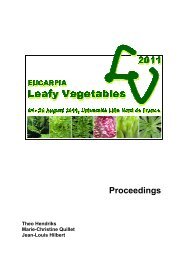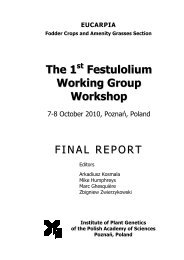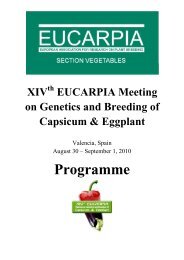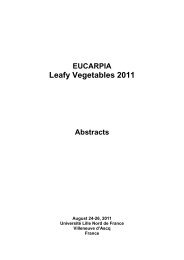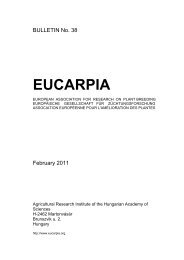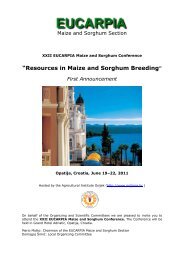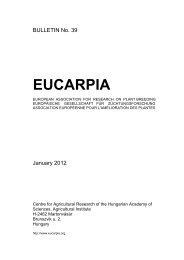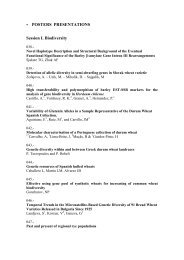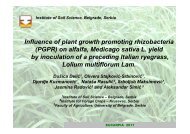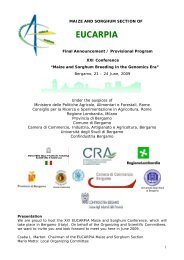Plant breeding for organic and sustainable, low-input agriculture
Plant breeding for organic and sustainable, low-input agriculture
Plant breeding for organic and sustainable, low-input agriculture
Create successful ePaper yourself
Turn your PDF publications into a flip-book with our unique Google optimized e-Paper software.
Appropriate <strong>breeding</strong> approach <strong>and</strong> type of cultivar in <strong>breeding</strong> faba bean <strong>for</strong> <strong>organic</strong><br />
farming<br />
Lamiae Ghaouti, Wolfgang Link<br />
Department of Crop Sciences, Georg-August University, Göttingen, Germany<br />
As <strong>organic</strong> farming refrains from the use of agrochemical <strong>input</strong>s, the <strong>organic</strong> environments are<br />
characterized by a large environmental heterogeneity. There<strong>for</strong>e, genotype × location interaction<br />
is expected to be larger across <strong>organic</strong> cropping areas than across conventional ones. So far,<br />
<strong>for</strong>mal plant <strong>breeding</strong> generally has concentrated on increasing yield <strong>and</strong> quality in environments<br />
that were modified by application of agro-chemicals. The importance of adaptation to variable<br />
<strong>and</strong> even risky <strong>low</strong>-<strong>input</strong> conditions often found in <strong>organic</strong> farming received little or no<br />
attention. A strong asset of local <strong>breeding</strong> is the possibility to select in the target environment<br />
<strong>and</strong> to exploit genotype × location interactions, being repeatable over time. There<strong>for</strong>e, the<br />
objective was to compare <strong>for</strong> faba bean the effectiveness of local <strong>breeding</strong> <strong>and</strong> <strong>for</strong>mal <strong>breeding</strong><br />
<strong>for</strong> grain yield in <strong>organic</strong> farming <strong>and</strong> to compare the per<strong>for</strong>mance of inbred lines <strong>and</strong><br />
corresponding synthetics using the two <strong>breeding</strong> approaches.<br />
The material involved included a set of 18 inbred lines, their polycross progenies <strong>and</strong> 13 checks.<br />
The entries were tested in four <strong>organic</strong> locations <strong>and</strong> one conventional station in Germany in<br />
2004, 2005 <strong>and</strong> 2006. Three <strong>organic</strong> farmers were involved in a participatory <strong>breeding</strong> approach<br />
<strong>and</strong> gave a score of a personal appreciation to the material tested in their farm.<br />
Results showed that the correlations between the personal appreciation scores attributed to the<br />
studied locations were very <strong>low</strong> <strong>and</strong> sometimes even negative. Personal appreciation score was<br />
strongly influenced by biotic <strong>and</strong> abiotic constraints faced by the crop in each location. For grain<br />
yield, genotype × location interactions were the highest component of the genotype ×<br />
environment interactions <strong>and</strong> contributed more than three quarter as much as the genotypes to the<br />
yield variation. The genetic correlations between the locations <strong>for</strong> grain yield were generally<br />
<strong>low</strong> indicating that the per<strong>for</strong>mances in the studied locations were controlled by substantially<br />
different sets of genes. To increase gain from selection in an <strong>organic</strong> location, local <strong>breeding</strong><br />
proved to be markedly more efficient than <strong>for</strong>mal <strong>breeding</strong>. Based on the genotypic per<strong>for</strong>mance<br />
<strong>and</strong> variance of inbred lines <strong>and</strong> synthetics at the first generation Syn-1, <strong>and</strong> on intensity of<br />
selection, the best Syn-1(4) <strong>and</strong> the best inbred lines were predicted. Despite the large variance<br />
of inbred lines available in local <strong>breeding</strong>, due to the partial realization of heterosis in the<br />
synthetics, these were the best per<strong>for</strong>ming in both <strong>breeding</strong> approaches. Unlike pure lines, they<br />
are providing the option of further local evolution <strong>and</strong> adaptation over time.<br />
56




